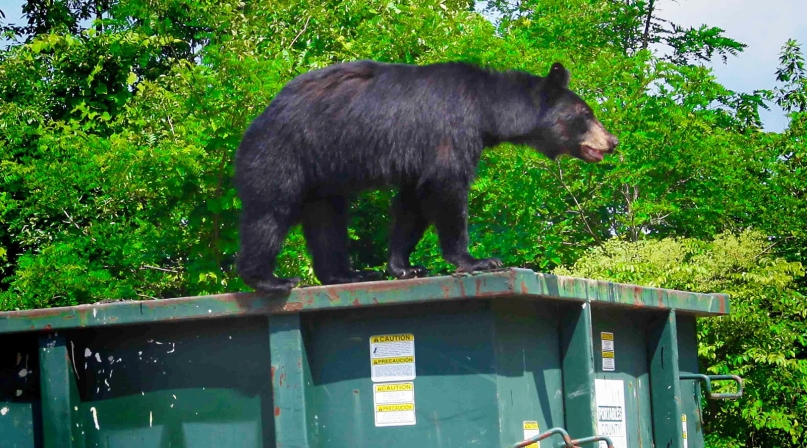Urban, rural settings alike are ripe for wildlife interaction

Key Takeaways
Sooner or later, the bears come for what’s theirs.
What’s theirs is anything they can eat.
Fall is usually bear season, when they gather enough food ahead of hibernation, but this spring and summer have seen a number of out-of-season bear sightings in residential neighborhoods around the country that are catching residents and county governments by surprise. And farther away from their developed communities, humans’ travel routes are snarled with animals.’
“Bears had a particularly hard natural food year last year, and so we had a lot of bear sightings and bear conflicts in Missoula, more so than in the recent past,” said Shannon Therriault, environmental health director for the Missoula City-County Health Department in Montana.
If Missoula, home to the University of Montana Grizzlies, is too obvious, counties in the Mid-Atlantic are seeing some black bears moseying nearby. Morris County, N.J. had to close one of its parks and trail systems for several days in June when an aggressive black bear was roaming near park users and their dogs. There were also bear sightings in suburban counties including Fairfax and Arlington counties in Virginia, Montgomery and Prince George’s counties in Maryland, Bucks County and Cumberland counties in Pennsylvania.
Missoula County’s bear buffer zone, which covers the city of Missoula, requires garbage to be kept in a bear-resistant container or kept inside until 7 a.m. on pickup day. The health department has proposed an expansion, and that proposal is open to public comment. Outside of the buffer zone, garbage collection is an optional service for all non-rental properties.
“It would capture that wildland-urban interface area so there’s not like there’s free access to garbage and then they get further from town and there’s less access to garbage,” Therriault said.
Both the Board of Commissioners and the city council would have to approve that change. A study between 2018-2021 found that 49% of human-bear interactions in Missoula County results from garbage.
The city and county passed a resolution in pursuing a “bear smart” community designation, pursuing a bear management plan pioneered in Canada.
“Our elected officials are really interested in finding the solution so we know we have support and we have that resolution that helps support us,” Therriault said.
Bears aren’t the only wildlife interface humans are experiencing, and with 48 bear-related fatalities in North America from 2000-2017, there are far less risky interactions. Development and growing transportation networks in rural areas run the risk of interrupting migration patterns though wildlife corridors, increasing the chance of human-wildlife interface and posing a danger to migrating animals. The Federal Highway Administration reports approximately 200 human deaths and 26,000 injuries from wildlife vehicle collisions in the United States annually.
University of Wyoming conservation fellow Travis Brammer presented his research to NACo’s Western Interstate Region Conference in Washington County, Utah in May 2023.
“These corridors and this connectivity are under a pretty significant threat,” he told county officials. “As people continue moving West, they tend to build homes in those connectivity areas, they also build additional roads, there’s all that other infrastructure that comes from more people moving to an area.”
“There are a lot more people driving on the already built roads, so those connectivity areas and those migration corridors are under pretty significant threat,” he noted.
Improved connectivity policies could cut the 1 million to 2 million annual collisions by 90%, he noted, citing a 2023 study by the Pew Charitable Trusts. The crashes result in lost hunting opportunities, vehicle repairs, towing and carcass removal.
Brammer said that counties’ land use authority is a hidden strength, not just by including fencing along roads.
“Counties do have a lot more control over these connectivity policies that that they’re not getting credit for,” he said. “Having a narrow focus at the county level can be really beneficial,” as opposed to a broader, more superficial planning approach.
“States can kind of get away with having a land use and a transportation plan and an energy plan,” he said. “The counties we spoke to said they are really honed in on one aspect of connectivity. They tended to get a little bit more support and see longer-term success.”
He noted that the county level can get much quicker and more efficient feedback from their constituency and make sure that the plans and these policies really meet their goals and their needs.
That focus also translates to the county role in requesting funding.
“When a country has something on the books, it makes it much easier to request funding from the feds or the states and if they have something on the books they can use that in that coordination process,” Brammer said.
A funding opportunity for this specific kind of project is open for the next month.
The Wildlife Crossings Pilot Program of the Bipartisan Infrastructure Law has authorized $350 million in competitive grants for which counties are eligible for construction projects, including wildlife crossing overpasses or underpasses or non-construction including a hot spot analysis of wildlife vehicle crashes.
Those grant applications through the Federal Highway Administration are due by Aug. 1.
For more information, contact wildlifecrossings@dot.gov.
Attachments
Related News

States file lawsuit challenging FEMA’s new rules on emergency management grants
On November 4, a coalition of 12 states filed a lawsuit against the U.S. Department of Homeland Security (DHS) and the Federal Emergency Management Agency (FEMA), alleging that recent changes to key emergency management grants are unlawful and could disrupt state and local preparedness efforts.

County Countdown – Nov. 4, 2025
Every other week, NACo's County Countdown reviews top federal policy advocacy items with an eye towards counties and the intergovernmental partnership.
FEMA bill staffers offer insights into reform effort
NACo Intergovernmental Disaster Reform Task Force heard from staffers who helped shape a bill that would make dramatic changes to the Federal Emergency Management Agency.
